South African Amarillis is a beautiful spectacular flower whose name has become common to the whole family of amarylline. A beautiful multi-altar conquers flowerflowers once and forever. True, in Russia, Amarillis is not as popular as Hippeastauram, Clivia, Narcissus and Galantas - his close relatives. The reason is that the thermal-loving amaryllis cannot boast of high frost resistance, so its cultivation in the open ground in the conditions of a harsh Russian climate is not practicing. But the plant has proven itself as a beautiful indoor flower, the present home decoration! How to care for Amaryllis at home, read the article.
Amarillis: Quick description
The climatic conditions of South Africa, Australia and the southern countries of the United States are suitable to Amarillis perfectly. In these latitudes, Amarillis are as widely as wide as dandelions in our country. The temperature -9 ° C is unsafe for the vital activity of the South African Plant. Air petals of buds and delicate leaves of Amarillis can suffer even with a smaller frost. That is why our floweries consider exotic culture exclusively as a room plant with pronounced periods of growth and peace.
Amarillis belongs to the culture of bulbous plants. It is distinguished by an extended (up to 70 cm long) straight and not wide (up to 2 - 3 cm) leaves that grow by two rows. The bulbs reaching 12 cm in the diameter resemble the mid-sized pear. During the flowering period, Amarillis will acquire one, less often with two, long and smooth blooms, crowned with great inflorescence. Inflorescence make up flowers-bells with a pleasant weak aroma to 5 - 8 cm in the diameter. Their color varies from white to all sorts of shades of red, pink and purple palette. The spindle-shaped Buds of Amarillis are blown up on 6 petals with sharp tips. Today, Amarillis is unanimously recognized as one of the most spectacular plants for growing at home.
Amarillis: the specificity of the life cycle in natural and home environment
The flowering period of "immigrants" from South Africa coincides with the fall, which in the hot countries begins in March and lasts until May. It is no coincidence that the locals nicknamed Amarillis Easter Lily. Resting and taking strength in summer, the bulbs of the plant produce flowers with large buds. On one inflorescence can simultaneously "sit" up to 12 flowers, and some hybrids - up to 20!
At home, Amarillis boasted with chic flowers up to 6 weeks and only after the completion of flowering, its leathery leaves rub through the ground. They will be green and elastic throughout the winter. Faming and crumpled leaves show the beginning of the next rest period. At this time, the bulbs need to be stored in a dry place at a temperature of + 10 ° C.
Amarillis: Care in different periods of cycle
Growing and care for Amarillis at home - the task is quite painstaking: to achieve lush and beautiful flowering, the plant needs to pay a lot of attention. But if you show enough patience and follow all the recommendations for the surveillance, watering and illumination of the exotic flower, you can force it to bloom 2 - 3 times a year.
Requirements for lighting and humidity
Amarillis does not live without bright scattered light. The best plant will feel on the windows facing southeast or southwest. If you settle the amaryllis on the southern window, there will be a mandatory shading on sunny days. So that the slender flowers were smooth, the pot from time to time turn to the light opposite side.
At the humidity of the air in the room, Amarillis responds not so sensitive as to the lighting, but still it is sometimes able to wipe it with a wet washcloth or rinse them in the shower. Please note that the blooming Amarillis has such water activities contraindicated. If the air in the room is very dry, you can slightly moisten from the pulverizer buds, but in no case you can not spray the extended flowers and "sleeping" bulbs.
AMARLILER ACTIVE GROWTH
With the arrival of spring, the need of Amarillis in the abundance of light and heat increases sharply, while the temperature should be kept within 18 - 25 ° C. The plant can be water if its bloomer has reached a height of 10 cm. If you hurry with irrigation, the amaryllis will waste all the energy to put into the growth of the leaves, and then the flowering time will be shifted indefinitely.
Healthy and strong bulbs immediately release a couple of arrows and bloom twice a year if the conditions allow. When there are 3 or more flowers, you need to leave only 2 of the strongest, removing the rest, otherwise the next time Amarillis simply refuses to bloom. December - April is considered to be a natural period of distillation for this bulbous culture. At this time, Amarillis is full of strength, and during the summer months it rests and is restored.
Period of flowering Amarillis
Flowering Amarillis as never needs in bright lighting and regular watering. Direct the jet of water on the bulb is strictly prohibited. If we talk about frequency and quantity of irrigation, remember, from which hot countries got to our windowsill, an exotic plant, and we conclude: it is better to not be discolored than to pour. Amarillis's short-term drought can be easily transferred, but there is no excessive moisture.
In order for as long as possible to admire the chic colors of the plant, the pot needs to be placed in a secluded cool place, where direct sunlight cannot penetrate. As soon as the first bud, the blooming is recommended to cut and put in the vase. The flower in the vase will bloom about the same as much as on the bulb, but the cutting of the first inflorescence will push Amarillis to the release of the new boom.
After flowering, Amarillis needs a gradual limitation of irrigation, which in the end must be stopped at all. With the onset of the rest period, cut the leaves from the plant can not - the bulb will pull out of them all the nutrients. "Sleeping" Amarillis in a pot is cleaned with a well-shaded cool place with a temperature of about 10 ° C. For a full rest, the plant requires at least 3 months.
Amarillis: landing rules
A plant having South African roots, you need to transplant not before the start of the growing season, and immediately after the completion of flowering when the leaves begin to grow. This will allow Amarillis bulbs to quickly recover and relax.
To at the time of extracting from the old pot, the plant does not injure, the land is pre-watered. Then Amarillis is gently taken out so as to protect the roots and save the earth on them. A new pot, superior to the former capacity in size, is filled with a layer of drainage and a humid nutrient mixture. There are immersed on the bulb together with the ground on the roots, and the free space along the edges fill in the new soil, after which it is condensed and slightly moistened. If, at the time of transplanting Amarillis managed to acquire "kids" with the meetings of its own roots, they are taken away from the parent plant and searmed into separate small pots.
Note! After the "moving" into the new pot of the bulb of the plant on 1/3 - 2/3 should be towering above the level of soil, and the distance from it to the edge of the planting capacity should be no more than 3 cm.
Before boarding Amarillis, you can purchase a special soil for decorative bulbous crops. This mixture has all the necessary qualities for the successful growth of the amaryllis - it is loose, light, with a level of acidity in the range of 6.0 - 6.5. Substrate for indoor amaryllis can be mixed independently. You will need the following components:
- equal parts of the turf and leaf land;
- half the volume of humus and peat;
- a little perlite. Instead, you can also use major sand or vermiculite.
Before boarding the amaryllis bulbs, the finished mixture must be disappeared and thus make it sterile. This precaution will save the root system and scales of plants from insects, among which the most dangerous - onion flies and nematodes.
Note! From transplanting resting in the summer of Amaryllis, it is worth refraining - unceremonious interference in the natural course of a life-year cycle of the plant may be deprived of its ability to produce flowerons.
Amarillis: Common Problems of Growing
The owner of an exotic plant may face some difficulties in the process of growing homemade Amarillis:
- the donta of the bulbs and the roots of the flower drowned - a consequence of frequent or abundant irrigation;
- lack of flowering - Amarillis did not receive suitable conditions for "hibernation";
- reluctance to bloom can also be caused by a sharp change of temperature (for example, a pot with Amarillis was moved to a balcony or garden);
- the flooded and faded leaves of the plant may indicate oxygen starvation of the root system of the Amaryllis, concluded in a too dense substrate.
As you can see, at home, an exotic bulbous plant is quite demanding to care. Therefore, before you buy Amarillis, we need to weigh all the "for" and "against". Beginner flowers can be recommended first to familiarize themselves with the agrotechnology of a less arrogant close relative of Amarillis - Hippeastrum.
Differences between Amarillis and Hippeastrum
These two plants look very similar to each other, so many confuse them. Meanwhile, the total two cultures only belong to the Amarillic family.
The cradle of Amarillis is beautiful, who is the only one of its kind, consider South Africa, while the natural weight of Hippeastrum is South America. In addition, this culture combines about 100 species of plants.
The most important and obvious distinctive feature of two plants lies in the features of the structure of the stem. The Amarillis stem floweros on the touch seems dense and homogeneous. That is why it is sufficiently stable in order to keep several large fragrant flowers (from 6 to 12). Arrow Hippeastrum, on the contrary, hollow. It appears a maximum of 6 buds, and the flowers are also odor.
List and other differences between Amarillis and Hippeastrum:
- Amaryllis flower smaller flower of hypapeastrum. Its size in diameter is approximately 8 cm, and the hypadastrum flowers reach 12 - 15 cm.
- The blooming amaryllis has no leaves, while the gippeastrum during the flowering period produces a removal sheet.
- Hippeastrum can exist only at home. Amarillis will be able to take root on the southern sector of the garden.
Amarillis: Premunition Features at home
Like the other representatives of the bulbous plants, Amarillies at home are multiplied by several ways:
- with the help of "kids", which appear on an adult plant;
- various methods of fissionions of the bulbs;
- seeds.
Obtaining offspring from Amarillis Vegetative means is not remarkable by any specific points, but the reproduction of this exotic culture seeds should be explored more.
The seeds of Amaryllis are not completely similar to those that are formed in pollination of the species related to him. Hippeastrum, for example, seeds are presented with dry black scales. If you do not obstruct the faded Amaryllis flowers and do not cut the arrow, then the nutrients that the plant will receive during irrigation will be used to form a seed box.
Amaryllis seeds are small juicy nodules, which, even being inside the fetus, can put miniature roots and tiny sprouts. This feature can be considered as dignity and disadvantage at the same time: from such seeds it is quite easy to grow a new instance of the plant, but also to suspend their soon germination is almost impossible.
A few weeks after pollination of the room Amarillis tubers are ready to germinate, and to get young plants, you need to hurry. To do this, sow seeds: carefully deepen them with the Donette in a slightly moistened sandy-peat substrate, and then put in place with good lighting. Seeds are rooted and thrown out the first sprouts in 3 - 6 weeks. Amarillies, resulting from reproduction by seeds, begin to bloom 4 - 5 years later.
Note! The major size and good development of bulbs may affect the fact that in the first year of life they will not be resting. Until the next rest period, they will continue to grow and build up the foliage. At this time, you need to provide young Amarillies with additional artificial lighting.
If the seeds of the bulbous plants are not immediately planted, they are stored in the home refrigerator, pre-packing in tightly closed packages. It is very important that moisture penetrate there. You also need to protect the tubers from the effect of negative temperature. From time to time, landing material must be inspected to detect mold or dried tracks in a timely manner if they appear.
Why amarillis does not bloom
Bulb plants love and respected for gorgeous flowering. But in the absence of the necessary care, the Amarillis will undoubtedly refuse to please the owner long-awaited flowers. The reasons for "strike" a lot:
- the bulb was not at rest and did not gain strength for flowering;
- the plant did not have enough sunlight or natural light;
- flower "frozen" in the cold room;
- earth in a pot is not fertile;
- the bulb "ate" pest insects.
Each of these factors turns the forces of the amaryllis and the plant is not enough energy to throw the arrow. In order to admire the beautiful bloom, all negative conditions are trying to eliminate.
Amarillis: Diseases and Pest
All plants in one degree or another are influenced by various pests and diseases. Amarillis did not exception: insects are danger not only for its flowers and leaves, but also for the underground part. Most often, the owners of Amaryllis face such pests:
- amarillix Cherver - White Pest, which usually hides under the scales of the bulbs. Insect life waste is a nutrient soil for breeding a sage fungus, seriously affecting the bulb. Amarillis shows that he is bad, slowing down growth and dropping leaves. To remove the sever, the indoor plant is treated with special insecticidal agents;
- onion tick - insect can get to the amaryllis together with the soil, which was not subject to disinfection processing. The pest eats the tissue of the bulb, destroying it in this way. In addition, the onion tick provokes the development of fusariosis. The plant cares in front of: the green leaves are flexible and begin to yellow, inflorescences are becoming smaller. The most favorable conditions for the appearance of the onion mite - a stuff and a large moisture in the room;
- mute Cherver - White Fluffy Spots, namely, the pest looks like, focus on the leaves and the stalk of the plant. You can get rid of it, regularly rubbing Amarillis with a damp sponge;
- falconist - brown spots are striking leaves and amaryllis flowers. The pest is getting rid of a soap solution or a special insecticide.
The presence of insects on the room Amarillis is also complicated by the fact that pests provoke the development of diseases dangerous to the plant, among which are most often found:
- fusariosis - infectious rot, affecting the fabrics and vessels of the root system of the plant;
- anterastosis - disfiguring the leaves of the Amaryllis dark stains and brown sweeps;
- stomponorosis is a disease that causes redness of the plant bulbs. In the photo Amarillis with a red burn on the bulb:
The sick flower is isolated from other indoor plants, after which the affected leaves are cut off, handled the damaged bulb of a fungicidal agent (for example, the Bordeaux mixture), and also update the planting material.
Enhance the immunity of the blooming amaryllis will help feeding 1 time in 10 days. Special solutions for flowering plants are used as fertilizer (for example, emerald). After the completion of flowering, the plant does not fertilize. The feeder renew only after the length of the leaves and the appearance of a bloody.
Interesting to know
Despite the incredible beauty of flowers, Amarillis poisonous. This means that the plant represents a potential danger to curious little children and omnipresent pets - parrots, cats and decorative rabbits. The bulb fabrics are saturated with alkaloid lycoorrhin, which, falling on the mucous membrane, causes swelling and severe irritation. Large dose of Licarin causes serious poisoning.


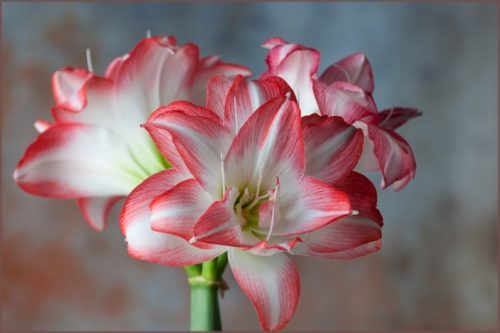
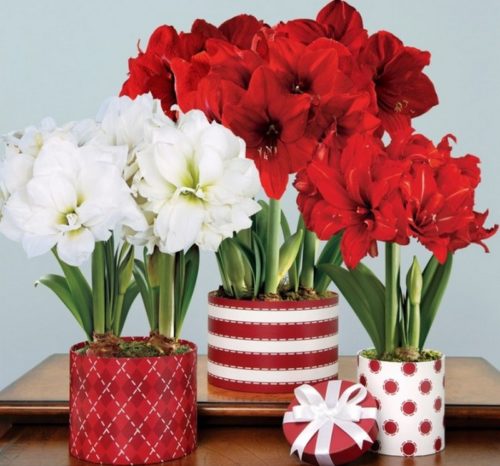

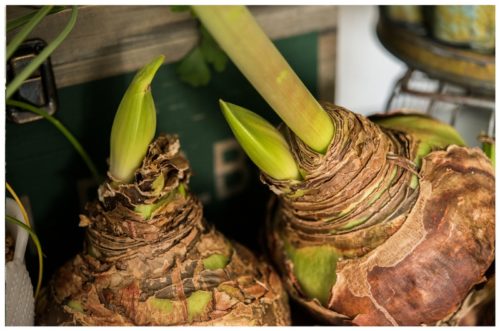
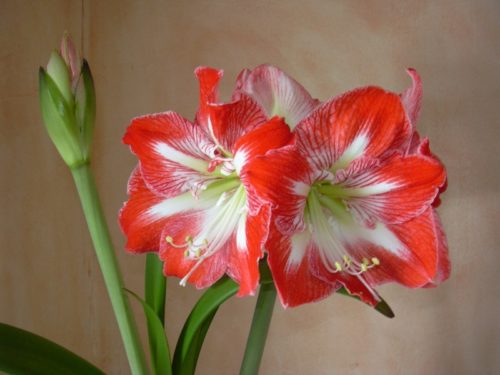
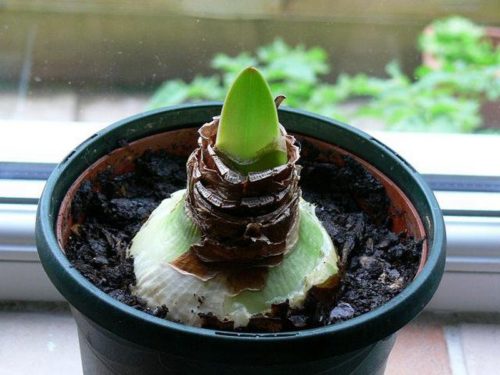
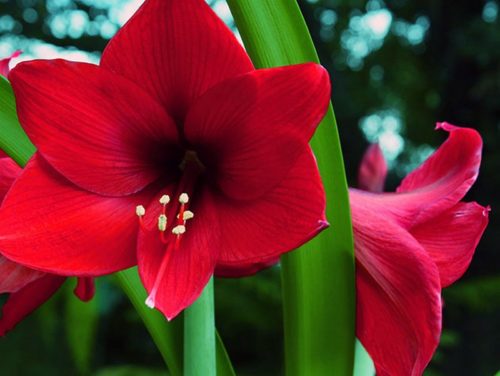
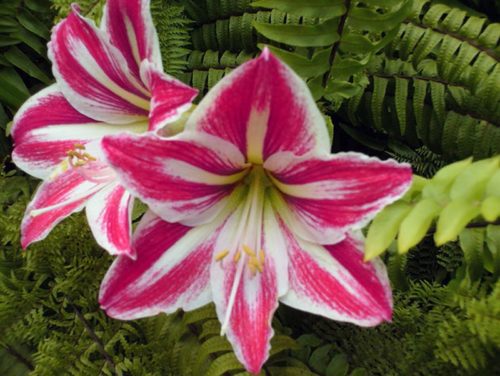
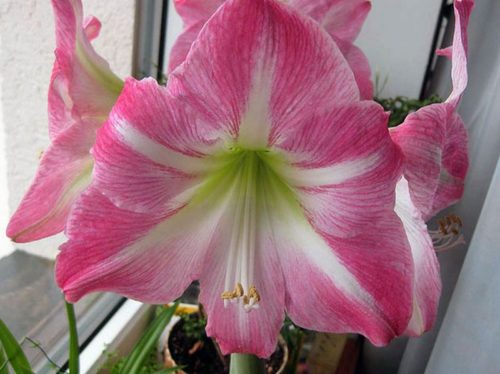
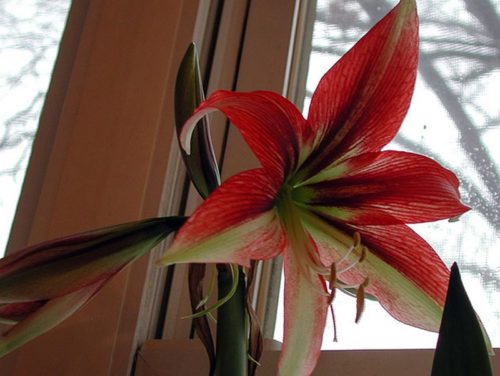

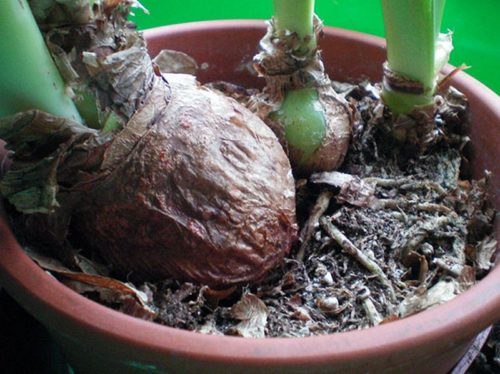
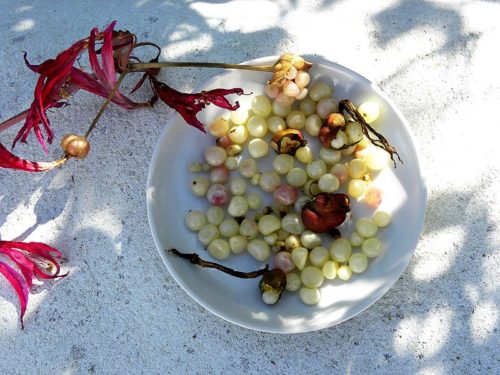
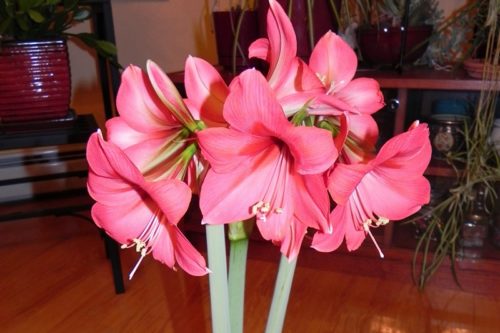
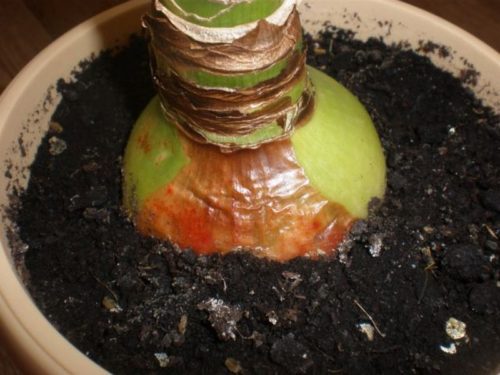












 Start a discussion ...
Start a discussion ...